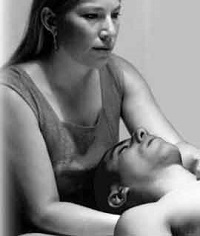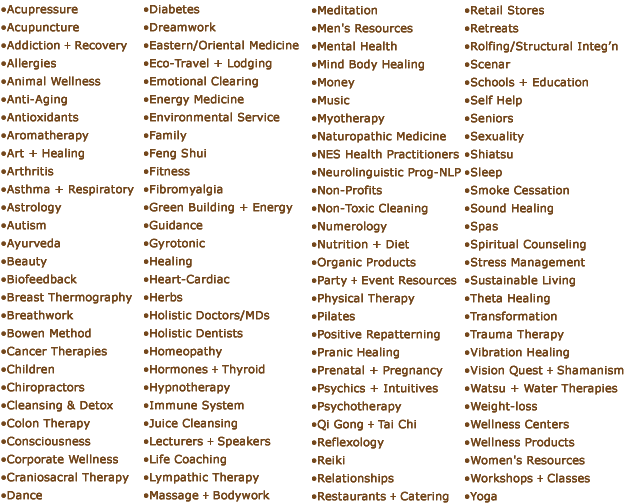We
live in a time when many of us are seeking a deeper meaning in
life and connection to self. As we look for what we value most,
touch and body awareness can be powerful agents of change.
Certified Rosen Method Practitioner
As
you hold yourself away from your feelings less and less, you connect
with a deeper, more authentic part of yourself. Your feelings,
your inner guidance, arises. You will trust and accept yourself
more--regardless of your outer circumstances, creating more health
and ease in your life.
"This
work is about transformation -from the person we think we are
to the person we really are."
- Marion Rosen
Read
articles
on the Rosen Method, including one written by Meg Butler.
Therapist's
hands-on method has gone worldwide
Marion
Rosen describes herself as a bodyworker and physical therapist.
Others call her a healer. Read more about Marion
Rosen & Rosen Method Bodywork in the San Francisco Chronicle.
What
is Rosen Method Bodywork?
Rosen
Method Bodywork Practitioners combine sensory input through direct
touch and verbal dialogue to deepen awareness within our clients
and explore the connections between the body and emotions. As
we engage the stopped movement (habitual tension) in our clients,
there is a conversation between our client’s body and our
hands. This “listening” with our hands to our client”s
body assists our clients to bypass the conscious mind and drop
into pure awareness and sometimes to allow unconscious and unfelt
feelings to arise. Added to this conversation, the verbal dialogue
can deepen awareness and, at other times in the session, can also
respectfully question the (once very useful) unconscious strategies
for protection in the muscle tension, bring awareness to the potential
cost (to the lives of our clients) of the tension, and investigate
the possibilities of other choices.
People
use their musculature to express their emotions, but when emotions
are not accepted or feelings are not allowed, we also use our
musculature to repress or contain the feelings. Muscular holding
over time becomes an unconscious habit and can cause chronic pain.
The muscles have "forgotten" how to relax.
As
a Rosen Method Practitioner, I work to "enliven" the
muscles rather than to manipulate the muscles or "make"
my clients relax. My clients put the tension into their bodies
at one time for a very good reason and it is not up to me to decide
if it is still necessary. The idea is to invite relaxation and
to bring consciousness to my clients so that they can make a choice
about whether or not it is safe to let go.
To
deepen awareness in my client, I may talk to my client about how
their body is responding under my hands, about the statement that
their body is making through the tension, or about their holding.
When we work in this way, sometimes memories and/or long held
beliefs arise. We can often get in touch with what has been contained
by the habitual muscle tension in their body and what happened
that the tension was necessary. When feelings are allowed, the
muscle softens, because the tension is no longer needed to hold
the feeling down. This frees energy, previously used in holding
the muscle, to be used for other purposes. Often, too, the circumstances
in our lives has changed and the reason we originally needed contain
our feelings is no longer present. Awareness and insights gained
in a session often lead to new possibilities and clarity in our
lives.
As
a Rosen worker, I am also very focused on the diaphragm and what
happens to the breath although I don't often talk about it in
a session (because I don't want to draw attention to the breath
- I am interested in the"unperformed" breath). Marion
saw that when the diaphragm lets go something would happen to
the body. "When the diaphragm lets go, then that feeling
of trust very often comes in. At that point worries, considerations
and insecurities no longer matter; another space is opening up.
The diaphragm swings and we are at peace with our aliveness,"
said Marion Rosen in an interview with Mara Lynn Keller, Ph.D.
And when the trust comes to the body then surrender can also come.
"This surrendering could be to God' or to that sense of connection
to the larger whole; to something beyond self. It means surrendering
the feeling that it is all up to me, that I have to do it all
myself," said Gloria Hessellund in the same interview.
To
facilitate this kind of experience, Marion taught me as a student
not to have an agenda, not to have an answer, but to sit in stillness,
patience and acceptance of another's suffering. I attempt to just
be present with myself and with the client and to sense the authentic
self beneath the holding.
What
is a session like?
 Meg
Butler is a Rosen Method Bodywork Practitioner in Santa Barbara.
In a private Rosen session gentle touch and verbal dialogue follow
the breath to invite relaxation and awareness. As this process
unfolds, truths held in the body surface and a deeper self emerges.
While many come to Rosen for support with physical injury, others
are drawn to the work as a tool for healing and personal growth.
Meg
Butler is a Rosen Method Bodywork Practitioner in Santa Barbara.
In a private Rosen session gentle touch and verbal dialogue follow
the breath to invite relaxation and awareness. As this process
unfolds, truths held in the body surface and a deeper self emerges.
While many come to Rosen for support with physical injury, others
are drawn to the work as a tool for healing and personal growth.
I
begin sessions with my clients lying on their belly on a massage
table. I get a sense of where my clients hold your tension, where
my clients allow movement, and where my curiosity about my client
begins. I also “listen” with my hands to the subtle
changes in muscular tension and breathing. My client and I may
talk about how their body is responding under my hands or what
happened that they needed the tension in their life.
This
is not something that I do to a client. This is a journey that
we take together as my client’s truth unfolds. What happens
in each session is individual and will change from session to
session.
Sessions last an hour. Rosen Method Bodywork is beneficial in
single sessions and in a short series of sessions. It is most
effective, and goes deepest as an ongoing process.
Benefits
of Rosen Method
“The
mind is embodied in the sense that it exists within the body.
The brain engages in bidirectional communication with the body,
so that the state of the mind influences the body, and the state
of the body influences the mind. Emotions, too, are embodied and
given their power to affect physiology outside the skull they
are arguably the most embodied form of mental activity. The brain
circuits that underlie Emotional Styles have extensive two-way
connections with the immune system, the endocrine system [the
collection of glands that produce hormones], and the autonomic
nervous system [regulates the function of internal organs]. Through
traffic in one direction, from brain to body, the mind influences
our health. Through traffic in the other direction, from body
to brain, changes in our patterns of movement can affect how our
mind processes emotional information. It also suggests that the
body can become an alley in transforming emotion, meaning practices
that emphasize the body have the potential to modulate emotion.”
-
“The Emotional Life of Your Brain” by Richard J. Davidson,
Ph.D. with Sharon Begley 136
-
As we explore the stopped movement (habitual tension) in the
client’s body we bring awareness to the possibility of
greater ease of movement.
-
At times in the session, we bypass the conscious mind and help
the client access pure feelings.
-
At other times, the verbal dialogue can also respectfully question
the (once very useful) unconscious strategies for protection
in the muscle tension, bring awareness to the potential cost
(to the lives of our clients) of the tension, and explore the
possibilities of other choices. This can help challenge the
accuracy of our clients beliefs and behaviors, and can help
our clients reframe the cause of their distress.
-
This process directly engages the prefrontal cortex, resulting
in increased prefrontal inhibition of the amygdala, a structure
in the brain which becomes active when we feel anxious, afraid,
or threatened.
-
Oxytocin, which has been shown to be released by our brains
when our body is touched, also reduces activation in the amygdala
inducing feelings of contentment, calmness, security and reduction
of anxiety.
-
Reduces stress through the release of anti-stress hormones from
the endocrine system.
Effects the immune system for better immune function.
-
Positively effects the autonomic nervous system which regulates
internal organ function.
-
Relaxes muscle tension and chronic holding relieving physical
pain.
-
Increases flexibility and vitality.
-
Deepens physical and emotional awareness.
-
Invites personal growth.
-
Complements psychotherapy and spiritual practices.
-
Helps clients to live more intuitively.
-
Increases creativity.
-
Strengthens your connection to the support and guidance within
yourself.
-
Helps clients to realize our potential.
-
Allows truth and invites self acceptance.
-
Helps us to live more meaningful lives.

About:
Meg
Butler
LMT, Certified Rosen Method Practitioner
I
moved to Santa Barbara in 1980 to attend the University of California
where I earned a BA in biology.
In
1994 I was teaching massage at one of the local massage schools
and I had been practicing massage in Santa Barbara for five years.
While I enjoyed doing and teaching massage, I was looking for
a way to touch people more deeply. From my experience on and off
the table, I knew that feelings could be accessed through the
body, but most of the time I felt like I was rubbing over the
surface of my clients. A flyer was sent to the massage school
where I was teaching advertising a Rosen Method Introductory Workshop.
I
had not heard of Rosen Method before, so I called for more information
and eventually attended. I met Marion Rosen, the originator of
this subtle and profound bodywork method and Gloria Hessellund,
one of her early students. Marion was a tall woman in her early
80's at the time. I was impressed with Marion's attentiveness,
wisdom and honesty. She seemed to really "take in" everyone
she worked on and treat them with such appreciation for who they
were and what they had to do to survive. That reverence was evident
in the way she engaged the people she worked on with her touch
and her words. I knew after that workshop that I wanted to continue
training to work in that way.
I
entered the "intensive track" in 1995 and trained under
Marion for the next two years. I changed tremendously during the
course of my training.
My mother had died when I was six years old. To hold myself away
from the pain that I was experiencing, and to be accepted, I put
parts of myself away. This profoundly effected the way I lived
and especially effected the way I allowed myself to love and trust.
I had done a few years of talk therapy (and that helped), but
I did not "get" the physical barrier that I had created
in my body to protect myself from being hurt again - the cost
of that protection was that I was unable to allow intimacy. Through
my training and my personal work with Rosen Method, I have grieved
the pain surrounding that experience and I have included many
of those abandoned parts of myself. I feel much less physically
and emotionally rigid. I am more accepting of myself, and therefore,
I move through my life with more ease and a greater sense of well
being. My whole life has changed.
I
began seeing Rosen Method clients in 1999 while in my internship,
and became a Certified Rosen Method Practitioner in the spring
of 2001. I am currently continuing my education to become a Rosen
Method Workshop teacher. I live with my husband and two children
in Santa Barbara.
I
thoroughly enjoy the invitation to dive deeper into the mystery
of what it means to be alive and human that Rosen Method offers
us; I look forward to seeing you soon.
![]() Santa Barbara
Website Marketing
Santa Barbara
Website Marketing

 Meg
Butler is a Rosen Method Bodywork Practitioner in Santa Barbara.
In a private Rosen session gentle touch and verbal dialogue follow
the breath to invite relaxation and awareness. As this process
unfolds, truths held in the body surface and a deeper self emerges.
While many come to Rosen for support with physical injury, others
are drawn to the work as a tool for healing and personal growth.
Meg
Butler is a Rosen Method Bodywork Practitioner in Santa Barbara.
In a private Rosen session gentle touch and verbal dialogue follow
the breath to invite relaxation and awareness. As this process
unfolds, truths held in the body surface and a deeper self emerges.
While many come to Rosen for support with physical injury, others
are drawn to the work as a tool for healing and personal growth.

